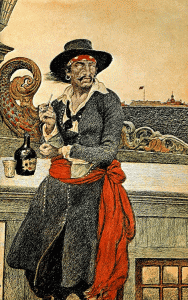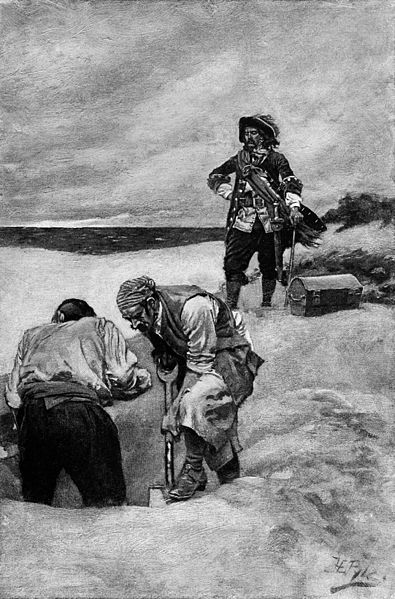
He was one of the most famous figures of the Golden Age of Piracy, yet some maintain that William Kidd was never a pirate at all. Certainly, he went to the gallows protesting his innocence. But in the space of a few short years, he sailed all over the world, first chasing pirates, before crossing the line into piracy himself – or so it was claimed.
Kidd was born in Dundee, Scotland, in 1654. We don’t know much about his early life, but by the 1680s he was living in New York City, which the British had just taken over from the Dutch. In 1689, he joined a French-English pirate crew in the Caribbean. He and other crew members mutinied, took over the ship, and Kidd was made captain.
Over the next few years, Kidd fought for the British against the French and Spanish, capturing several ships. His role was as a privateer, someone engaged in maritime warfare, but a private person rather than a member of the Royal Navy.
From privateer to pirate
In 1695, Kidd was asked by the Governor of New York to attack known pirates, along with enemy French ships. The cost of the venture was met by noble British lords, and Kidd was also given a letter of marque, essentially a licence to be a privateer, signed by King William III.
Kidd sold his old ship and commissioned a brand new one – the Adventure Galley. It weighed over 280 tons, had 34 guns and was manned by 150 men. Crucially, it also had two banks of oars – a rare addition, but one which made it much more manoeuvrable.
As it set off down the Thames, Kidd for some reason failed to salute a Royal Naval yacht at Greenwich. The yacht then fired a shot at him to make him show some respect. His crew responded by turning their backs and slapping their backsides in disdain.
A minor incident but, perhaps, a bad omen for the next and last time he would return to London, a few years later…
The voyages of the Adventure Galley
Kidd left New York in the Adventure Galley in September 1696, travelling first to Madeira and then Cape Verde, before heading south. However, problems soon arose. He found few ships to attack, and some of his men were dying from illness. His tired and frustrated crew wanted pressured him to take more extreme measures – essentially, to turn pirate himself.
In early 1697, he steered a course for Madagascar. After a few successes against small ships and a stopover in the Comoros Islands, in January 1698 he spotted a much larger ship rounding the tip of India. This was the 500-ton Quedagh Merchant, full of gold, silver, silk, spices, sugar and other goodies, and Kidd quickly took control of it.
Unfortunately for Kidd, the cargo aboard was part owned by a minster at the Court of the Grand Moghul. He complained to the East India Company, then the most powerful trading firm in the world. Kidd was now a wanted man.
The pirate brought to justice?
By the time he captured the Quedagh Merchant, the Adventure Galley was in poor shape, so he abandoned it and set off on his prize for the Caribbean. He eventually ended up in Boston, Massachusetts, where he was arrested (ironically, by one of the original investors in his voyage) and sent back to England.
In May 1701, Captain Kidd went on trial for piracy. It was a foregone conclusion. In the years since he had left England, piracy had become a criminal act and the government wanted to stamp it out. He had become an embarrassment to his original backers and, far from helping him, they helped to convict him.
These backers were prominent Whigs – an early forerunner of the modern-day Liberals, and in their politicking against the Tories (modern-day conservatives), Kidd was a helpless pawn.
Within a day he had been convicted and sentenced to death.
Just two weeks later, he was hanged. To serve as a warning to others, his body was placed in a gibbet on the bank of the Thames at Tilbury and left to rot.
The year after his death, Queen Anne ordered what remained of his booty and possessions to be sold. They raised £6,473 and one shilling. This was given to the Royal Naval Hospital at Greenwich and used to build the Queen’s House, which still stands today.
What about Captain Kidd’s treasure?
 After Kidd’s death, his legend grew – and so did the stories of his buried treasure. They weren’t unfounded either – before his fateful journey to Boston, he stopped off to bury treasure on nearby Gardiner’s Island and Block Island. Some of that left on the first-named was later recovered, but none was ever found on Block Island.
After Kidd’s death, his legend grew – and so did the stories of his buried treasure. They weren’t unfounded either – before his fateful journey to Boston, he stopped off to bury treasure on nearby Gardiner’s Island and Block Island. Some of that left on the first-named was later recovered, but none was ever found on Block Island.
And what of the riches of the Quedagh Merchant? Its cargo was worth an estimated £70,000 – the equivalent of many millions today. Surely at least some of the gold and silver remains somewhere to be discovered one day?
Many have certainly sought it over the years. A wreck, believed to be of the Quedagh Merchant, was found in 2007 off the Dominican Republic, but sadly no treasure. There was also great excitement in 2015 when a 50kg ingot was found in a wreck off Madagascar. But alas, it was found to be made of 95% lead. It’s also been claimed that part of Kidd’s treasure lies on the Island of Ko Wang Nok, off the coast of Thailand.
Today, people still seek the treasure of Captain Kidd. But in the Captain Kidd Pirate Ships Experience, we believe we are creating a modern-day adventure that’s just as valuable in its own way – and which will enrich the lives of thousands.
For details on this, please see All Aboard and check out our Learning Programme planned for our recreation of the Adventure Galley and the two further ships on the Thames.













